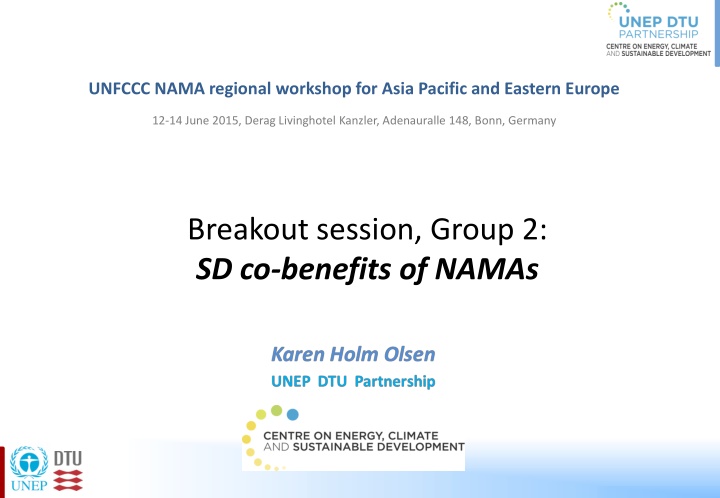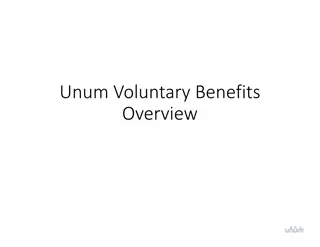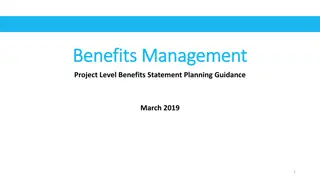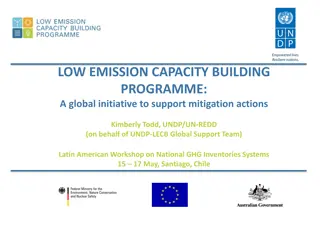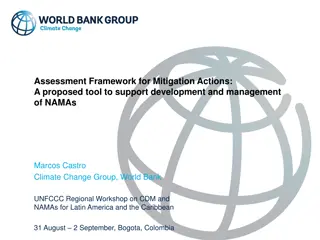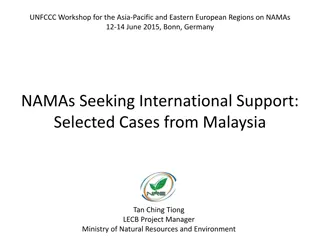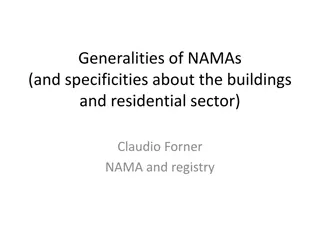SD co-benefits of NAMAs
The UNFCCC NAMA regional workshop in Bonn, Germany focused on Sustainable Development co-benefits of NAMAs. It included group sessions to assess SD impacts, quantifying indicators, and identifying key findings for various criteria like social, environmental, economic, and institutional aspects. Participants engaged in exercises to evaluate the impacts and implications of NAMAs on various sectors including energy, land, jobs, health, water, and more.
Uploaded on Mar 02, 2025 | 0 Views
Download Presentation

Please find below an Image/Link to download the presentation.
The content on the website is provided AS IS for your information and personal use only. It may not be sold, licensed, or shared on other websites without obtaining consent from the author.If you encounter any issues during the download, it is possible that the publisher has removed the file from their server.
You are allowed to download the files provided on this website for personal or commercial use, subject to the condition that they are used lawfully. All files are the property of their respective owners.
The content on the website is provided AS IS for your information and personal use only. It may not be sold, licensed, or shared on other websites without obtaining consent from the author.
E N D
Presentation Transcript
UNFCCC NAMA regional workshop for Asia Pacific and Eastern Europe 12-14 June 2015, Derag Livinghotel Kanzler, Adenauralle 148, Bonn, Germany Breakout session, Group 2: SD co-benefits of NAMAs
Session outline: Split into groups identify a reporter (5 min) Presentation of NAMA case in each group (10 min) NAMA SD assessment two exercises (60 min): 1) Identify SD criteria and indicators for NAMA SD impacts (30 min) o Describe the overall expected impacts of the NAMA for each criteria o Score the significance of the SD impacts, whether positive or negative using the following scale: Highly positive (+2), Positive (+1), Neutral (0), Negative (-1) and Highly negative (-2) 2) Quantification of SD indicators (30 min) Select at least two SD criteria to fill out the sheet Discuss whether it is possible and desirable to quantify all SD impacts or only key indicators Report back on key findings from each exercise (15 min) o o
NAMA Sustainable Development Taxonomy Social Environmental Institutional Economic Capacity Building Policy & Planning Growth Energy Air Land Jobs Health & Safety Balance of Payment Natural Resources Domestic MRV System Laws & Regulation Technology Welfare Water Education Growth Investment Industrial/commercial activities Economic growth/higher income Quality of life Increased tax base Infrastructure Production cost Productivity Other Energy Coverage/availability of supply Access Reliability, affordability Other Technology Imported technology Local technology Adaptation and viability in local area Other Balance of payments Dependency on foreign sources of energy Amount of energy produced from clean renewable sources Decrease in risk of political conflicts Economic savings for the government Reduction in energy subsidies Other Capacity Building Land titling processes Mapping of natural resources and renewable energy potential Development of competitive procedures Workshops and trainings A technical help desk for project developers and other stakeholders Other Policy & Planning Policy Framework for Sustainable, Low carbon Urban Transport Comprehensive Urban Low carbon Mobility Plans Other Domestic MRV System Sub national reference levels and MRV systems Platform for the Generation and Trading of Forest Carbon Credits Other Laws & Regulation Tariff reform Compliance with laws and regulation on Promoting and regulating production, sale and use of biofuels and biomass Decrees for tax benefits for renewable energy projects Conditions for competitive process for incorporation of new plants Other Air Jobs Long term jobs Short term jobs Sources of income Other Health and Safety Accidents Crime Diseases Number of hospital visits Sanitation Food safety Indoor air pollution No child labour Other Education Green development related training Educational services for different groups Project related knowledge circulation Other Welfare Traffic congestion Commuting times Income/asset distribution Women empowerment Municipal revenue Rural upliftment Energy security Other SOx, NOx, GHG Odor, Dust, SPM, Fly ash Noise Land Compost Manure nutrient and other fertilizer Soil erosion, Salinization, Acidification Minimum tillage End of life pollution Change access/lost access to land Other Water Waste water Leaks & diesel dumping Drinking water quality Water extraction rate Conservation Supply, water access Ecological state Purification Other Natural Resources Minerals Species diversity Plant life Land cover change Other
Exercise 1: Assess SD impacts Assessment of SD impacts Qualitative scoring: Selection of SD criteria (YES/NO) SD criteria and indicators Expected impacts of the NAMA intervention 2 1 0 -2 -1 Negative Positive Air SOx NOx GHG Odor Dust SPM Fly ash Noise Land Compost, Manure nutrient and other fertilizer, Soil erosion, Salinization, Accidification, Minimum tillage End of life pollution Change access/lost access to land Other Water Waste water Leaks from diesel storage facilities and dumping of waste oil during servicing of diesel generators Drinking water quality Water extraction rates Conservation Supply,water access (per number of people/area) Ecological state Purification Other Natural resources Minerals Species diversity Plant life Land cover change (area/type) Other Environmental
Exercise 2: Quantify SD impacts Quantification of SD indicators Number of indicators selected per criteria Name(s) of parameter(s) to measure indicator(s) Intervention value monitored (ex- post) SD criteria and indicators Unit of measurement Baseline value Target value estimated (ex-ante) Air SOx NOx GHG Odor Dust SPM Fly ash Noise Land Compost, Manure nutrient and other fertilizer, Soil erosion, Salinization, Accidification, Minimum tillage End of life pollution Change access/lost access to land Other Water Waste water Leaks from diesel storage facilities and dumping of waste oil during servicing of diesel generators Drinking water quality Water extraction rates Conservation Supply,water access (per number of people/area) Ecological state Purification Other Natural resources Minerals Species diversity Plant life Land cover change (area/type) Other Environmental
Feedback from the groups 1. How appropriate is the NAMA SD taxonomy for application to NAMAs? is anything missing? 2. What are the challenges for MRV of SD impacts regarding methods and data for quantification?
